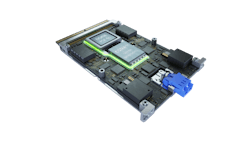Nokia unveils PSE-6s super-coherent optical engine for 1.2-Tbps to 2.4-Tbps applications
Nokia has unveiled the PSE-6s, the sixth generation of the company’s Photonic Service Engine. The device is designed to support 1.2-Tbps superchannel transmission – or 2.4 Tbps when two PSE-6s chips are linked together. The chip will appear on line cards for the 1830 series optical transport platforms in time for field trials during the second half of this year, with a goal of general availability by the end of the year.
According to Serge Melle, director of product marketing – optical networks at Nokia, the 130-Gbaud PSE-6s leverages a 5-nm process and advanced performance to reduce network power consumption by up to 60%. Melle believes a significant initial use case will be pairing two of the chips to support the transmission of as many as three 800 Gigabit Ethernet (GbE) streams over distances of 2000 km or more without the need for regeneration. Such non-regenerated reach for 800GbE is 3X that available with previous coherent engine generations, Melle asserts.
The improved performance and power consumption derives from a combination of the 5-nm technology, third-generation probabilistic constellation shaping (PCS) co-optimized with high-gain forward error correction (FEC), and related other tweaks, said Melle. The DSP offers continuously tunable baud rate capability and supports multiple shaped-QAM options. The device also supports the delivery of advanced telemetry with on-chip analysis that can be reported upwards to Nokia network administrative platforms or others via an open API.
The PSE-6s will come as a part of a multi-chip module that also will contain functions enabled via Nokia’s CSTAR silicon photonics platform. Melle said initial implementations will feature two chips per line card to provide 2.4-Tbps capabilities for such optical transport systems as the 1830 PSS, 1830 PSI-M, and 1830 PSS-x. In addition to 3x800GbE, the line cards will support up to 24x100GbE/OTU4 and 6x400GbE.
Nokia expects the PSE-6s will benefit not only long-haul applications but metro and data center interconnect as well. Melle said that the device also will support gridless transmission for submarine networks.
In addition to the super-coherent version, previous generations of the PSE have also included a “c” (for “compact”) version for integration into pluggable transceivers. Asked if this would be the case with the PSE-6, Melle said that the super-coherent PSE-6s was the only version of the device being introduced right now – which would appear to leave the door open for a PSE-6c announcement in the future.
For related articles, visit the Optical Technologies Topic Center.
For more information on optical components and suppliers, visit the Lightwave Buyer’s Guide.
To stay abreast of optical communications technology, subscribe to Lightwave’s Enabling Technologies Newsletter.

Stephen Hardy | Editorial Director and Associate Publisher, Lightwave
Stephen Hardy is editorial director and associate publisher of Lightwave and Broadband Technology Report, part of the Lighting & Technology Group at Endeavor Business Media. Stephen is responsible for establishing and executing editorial strategy across the both brands’ websites, email newsletters, events, and other information products. He has covered the fiber-optics space for more than 20 years, and communications and technology for more than 35 years. During his tenure, Lightwave has received awards from Folio: and the American Society of Business Press Editors (ASBPE) for editorial excellence. Prior to joining Lightwave in 1997, Stephen worked for Telecommunications magazine and the Journal of Electronic Defense.
Stephen has moderated panels at numerous events, including the Optica Executive Forum, ECOC, and SCTE Cable-Tec Expo. He also is program director for the Lightwave Innovation Reviews and the Diamond Technology Reviews.
He has written numerous articles in all aspects of optical communications and fiber-optic networks, including fiber to the home (FTTH), PON, optical components, DWDM, fiber cables, packet optical transport, optical transceivers, lasers, fiber optic testing, and more.
You can connect with Stephen on LinkedIn as well as Twitter.
